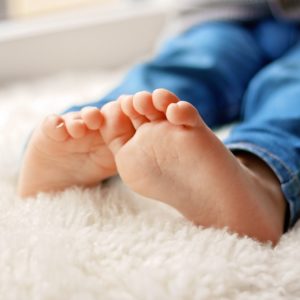Doctors’ Notes
BackIn-Toeing
Many parents notice their child turning his or her feet inwards when beginning to walk. In-toeing, or being “pigeon-toed,” refers to when a child’s feet turn inward instead of pointing straight.
 While it may seem concerning, the good news is that for most kids, it’s nothing to worry about. These conditions are common in childhood and usually improve as a child grows.
While it may seem concerning, the good news is that for most kids, it’s nothing to worry about. These conditions are common in childhood and usually improve as a child grows.
There are three conditions in healthy children that cause an in-toeing gait:
Tibial Torsion (shinbone turns inward)
Parents usually first notice this when a child is learning to walk and/or between 2-4 years old.
An inward twist of the tibia (shinbone) is a common finding in kids and usually corrects itself without treatment by eight years old. In the past, special shoes or braces were used to try to correct this positioning. Over time it was clear that these interventions did not lead to quicker straightening of the feet and legs, which correct over time as the child grows.
Femoral Anteversion (thighbone turns inward)
This is most commonly seen in children aged 3-10 years. Parents may notice their child’s kneecaps pointing inward when standing straight.
A most common complaint is that a child may appear clumsy, especially when running, and prefers to sit in “W” shaped position. This positioning also does not need to be corrected; it will improve as the child grows.
Metatarsus Adductus (foot turns inward)
Noticed in infancy, this refers to curving of the outer aspect of the foot. It’s thought to be due to positioning inside the uterus.
The curvature is usually mild and will resolve on its own before a year old. Parents can also perform gentle stretches a few times daily to help straighten the foot
If the curvature persists, your doctor will refer the child to a Pediatric Orthopedic Surgeon for further evaluation.
A more severe form of this problem is called Clubfoot, in which the infant’s entire foot is turned at an angle. This requires referral to an orthopedic specialist for a combination of stretching, casting, and bracing.
It Usually Just Takes Time
Remember, learning to walk takes time! The legs and feet of children rotate and change as they grow. The majority of the positioning changes that we notice do not require any special intervention — just time!
At Kids Plus, we will always do a careful examination of your child and monitor development closely. But i you have any concerns about how your child is walking or running, please let us know.
Danielle Anthony, PA, IBCLC, has been a Kids Plus Provider since 2017.
Will Nesbitt spent a rotation at Kids Plus as a PA Student from Slippery Rock University.